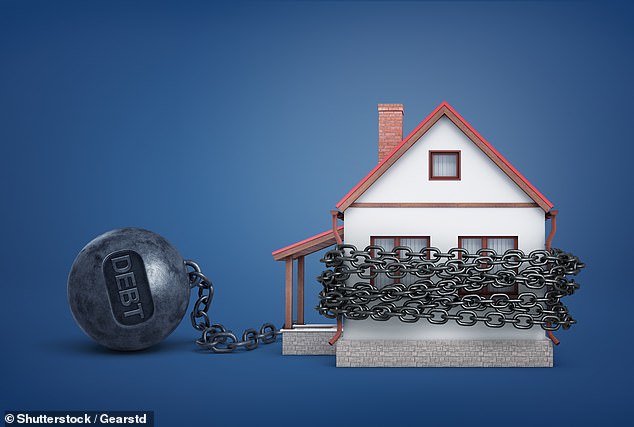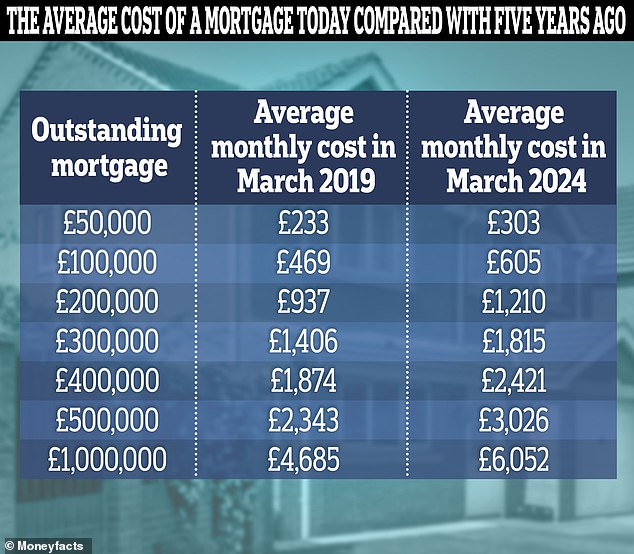Homeowners with a mortgage may have felt a looming sense of dread over the past two years.
Since rates began to rise, many of the UK’s nine million mortgaged homes and around two million buy-to-let homeowners have faced the prospect of much higher repayments.
Before that, many had become accustomed to ultra-low interest rates for more than a decade.
With each passing month, another 150,000 borrowers reach the end of their agreements with low fixed rates, and many find themselves moving to mortgage rates that are two, three or even four times higher.

Locked in: Homeowners often spend most of their income on their mortgage
For households, this will typically account for the majority of their total monthly spending.
But while mortgage holders have a right to feel aggrieved, how many of them are on the brink of financial ruin or headed in that direction? Some have described it as a “mortgage crisis”, but is this really the case?
In this six-part series, we look at how much more people are actually paying when they take out a new mortgage, how households are coping and whether a mortgage crisis is looming.
Firstly, we look at how many people are paying more for new mortgages compared to the cheaper deals many are rolling out.
How much more are we paying for mortgages?
Last week, the Office for Budget Responsibility (OBR) forecast that the average mortgage rate across all households will peak at 4.2 per cent in 2027.
This is up from a low of 2 percent at the end of 2021 and above the average mortgage interest rate in the 2010s of around 3 percent.
The average OBR rate includes all fixed and variable mortgage rates that households currently pay.
This includes those who remain on very low fixed rate agreements. This is why OBR rates tend to be lower than the average market rate for new home loans.
The average market rate, as reported by Moneyfacts, takes into account all fixed rate offers currently available to those purchasing or remortgaging.
The average two-year fixed-rate mortgage deal, according to Moneyfacts, is currently 5.78 per cent, while the five-year average is 5.35 per cent.
That’s significantly higher than the average two-year and five-year fixed-rate mortgages paid before rates rose in 2022.
For example, someone who took out a mortgage in March 2022 will now get an average rate of 2.64 percent, according to Moneyfacts.
On a £200,000 mortgage repaid over 25 years, that’s the difference between paying £911 a month and £1,262 a month when fixed over two years.


Based on the average cost of a five-year fixed-rate mortgage, according to data from Moneyfacts
Meanwhile, a five-year solution that was adopted in March 2019 would have an average rate of 2.89 percent.
For someone with a £200,000 mortgage to pay off over 25 years, that’s the difference between paying £937 a month and £1,210 a month.
Many people will get a cheaper rate than average, especially if they have more equity in their home and a good credit profile.
However, even those with the largest deposits or the most capital will see their costs rise. Exactly five years ago, the cheapest five-year solution was 1.79 percent. Now it is 4.09 percent.
For someone with a £200,000 mortgage to pay off over 25 years, that’s the difference between paying £827 and £1,066 a month.
As for someone moving from the cheaper two-year fix in March 2022, which was 1.64 per cent, to the cheaper two-year fix of 4.6 per cent now, the jump will be even bigger.
On a £200,000 mortgage repaid over 25 years, that’s the difference between paying £813 a month and £1,123 a month.
Arjan Verbeek, chief executive of mortgage lender Perenna, says: “Those who remortgage will experience a significant increase in their monthly payment, which is typically the biggest fixed cost most people make.”
‘Some might be able to withstand this sharp increase, but at what cost?
‘The cost of reducing consumption elsewhere and being forced to make concessions, whether it be postponing important life events like getting married or starting a family, not being able to go on a well-deserved vacation, or instead being forced to go on your retirement savings.’
However, for now, many mortgage holders remain protected from higher interest rates thanks to their fixed term agreements.
David Hollingworth, associate director at L&C Mortgages, says: ‘There is an element of timing which means the level of the crisis will largely depend on when the last deal was done and for how long.
‘Many are far from the crisis having been able to witness the worst of the rise in mortgage rates from the comfort of a low and constant fixed rate.
‘For those homeowners who have opted for higher rates, they will reduce accordingly and curb spending to prioritize their mortgage payments.
“No one will find it easy to come up with an extra few hundred pounds a month, so this is certainly a challenge for borrowers.”
Some links in this article may be affiliate links. If you click on them, we may earn a small commission. That helps us fund This Is Money and keep it free to use. We do not write articles to promote products. We do not allow any commercial relationship to affect our editorial independence.


